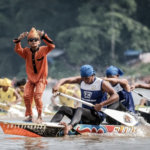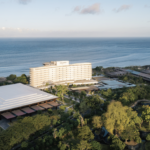Over 1,200,000 people visited Christo and Jeanne-Claude’s The Floating Piers during its 16 days from June 18 through July 3, 2016. The temporary work of art featured fabric-covered piers 3 kilometers in length, constructed across the water of Italy’s Lake Iseo, and continued along 2.5 kilometers of pedestrian streets in Sulzano and Peschiera Maraglio.
“Each project is a slice of our lives and something that I will never forget,” said Christo. “Jeanne-‐‑Claude and I first conceived The Floating Piers in 1970. I later found Lake Iseo to be the most inspiring location to realize this project. The Lake’s water, the landscape, and the communities around it have all been part of The Floating Piers. An important part of this project is the temporary part, it has a nomadic quality—this is why after 16 days it is gone.”
The Floating Piers was free and accessible to the public, no tickets or reservations were required. Local authorities requested The Floating Piers close at night to accommodate the community of Monte Isola’s sanitation needs. On average over 72,000 people a day from around the world experienced The Floating Piers and explored the hosting communities around Lake Iseo, which offered food and drinks, and places for hikes where visitors could take in different vantage points of the piers.
“Monte Isola was ‘Caput Mundi’ [Capital of the World] for 16 days,” said Fiorello Turla, Mayor of Monte Isola. “I was there, I’ve been part of this incredible event that was The Floating Piers. Hotels, restaurants, bars, and shops recorded astonishing attendance, and images of Lake Iseo were broadcast on the major international networks. For my small island it’s been a challenge that we enthusiastically met and we are grateful for this wonderful experience, which will have lasting impact on the future of the tourist industry of our area.”
“The Floating Piers has been a great success, despite any doubt,” said Giuseppe Faccanoni, President of Lake Basin Authority, “but the most interesting thing is that it provided new perspectives for inhabitants around the lake. It allowed us to rediscover our surroundings and the value of the lake’s inner beauty, which can sometimes be underestimated.”
“The Lake Iseo area hosted over a million visitors, offering an unforgettable artistic experience and allowing people to learn about a hidden corner of Italy,” said Paola Pezzotti, Mayor of Sulzano. “We have been at the center of a contemporary artistic experience and the international tourist circuit. The attendance of visitors and all the investments brought by The Floating Piers benefits our local economy and will enable even broader social and tourist development in years to come.”
Christo financed the entire cost of The Floating Piers, approximately 18,000,000 Euros, including the assembly, installation, maintenance, security, and removal of the work of art. The artist does not accept sponsorship. The total includes planned support for local government agencies and host communities in the Lombardy Region, totaling 1,500,000 Euros. This funding covered services such as police, ambulances and fire personnel and for installation of telecommunications in the nearby tunnels. It also included concession fees for use of Lake Iseo and the communities of Sulzano and Monte Isola. Additionally during the project, Christo paid for extra garbage removal, portable toilets, and other sanitation assistance for the surrounding area.
Over 1,000 people were employed by The Floating Piers. All project workers are paid, there are no volunteers, including manufacturers, engineers, building contractors, divers, pier monitors, lifeguards, boat captains, and security personnel. The majority of the monitors, which provided round-‐‑the-‐‑clock coverage on the piers, were local Italian residents from the Lombardy region. Project leaders include Vladimir Yavachev – Operations Director, Wolfgang Volz – Project Manager and Official Photographer, Rosen Jeliazkov – Director of Construction, Josy Kraft – Registrar/Curator, Germano Celant – Project Director, Izabella Tzenkova – Operations Coordinator, Marcella Ferrari – Administration Director, and Mario Boero – Event Security Officer.
“We had people from all over the world come to work with us just because they wanted to be a part of this work of art,” said Izabella Tzenkova.“Many stayed longer than expected and found it hard to say goodbye.”
Information on Materials and Removal:
Removal of The Floating Piers will begin July 4, and materials will be industrially recycled for use in a variety of applications. The recycling involves several different processing methods, and will take place at various locations in Europe.
“We are grateful to all the local leaders and authorities for their partnership on this project,” said said Vladimir Yavachev. “Maintaining the Lake and its surroundings continues to be a top priority for us. We will remove all components of The Floating Piers over the course of three months, and we will leave Lake Iseo as if we were never here.”
The Floating Piers included:
• 220,000 high-density polyethylene cubes and pins, manufactured by four different companies in Northern Italy, used to create a modular floating dock system on Lake Iseo. The cubes will be re-‐‑granulated onsite and the material will be re-‐‑used in the plastics industry.
• 100,000 square meters of nylon fabric and 80,000 square meters of felt, from three companies in Germany, to cover 3 kilometers over the piers on water and 2.5 kilometers of pedestrian streets. The yellow-‐‑dahlia fabric as well as the felt underlay will be re-manufactured and used in the production of new fabric products. The fabric may also be ground into a filler and used in such products as carpet underlayment.
• 200 concrete dead-weight anchors, weighing 5.5 tons each, specifically designed for the project. The anchors, used under water to hold the piers in place, will all be carefully removed from the lakebed and milled/shredded for filler and industrial re-use.
“A part of the project that visitors never saw is the unique and incredible anchoring system beneath the piers designed by Rosen Jeliazkov,” said Christo. “Rosen and his team have been with us since the start of this project, helping us to realize this very technical and essential aspect of The Floating Piers. I want to thank everyone who worked on The Floating Piers—we could not have done it without so many experts and specialists.”
Following the completion of The Floating Piers, Christo will return his focus to two works in progress he began with Jeanne-Claude;
The Mastaba, Project for the United Arab Emirates, (started in 1977) and Over the River, Project for the Arkansas River (started in 1992).
Contacts/information:
press@thefloatingpiers.com
Photo credit: Wolfgang Volz;
The Floating Piers website:
www.thefloatingpiers.com
Christo and Jeanne-Claude website:
http://christojeanneclaude.net
Follow the project:
Facebook : www.facebook.com/floatingpiers
Instagram : floatingpiers
Twitter : @floating_piers










